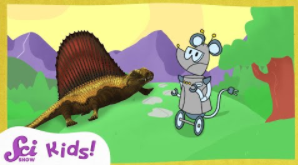Wow, it’s amazing how small these are.
哇,这些东西真是太小了。
Squeaks and I have been learning about living things from a long time ago, like the bacteria homes called stromatolites, and these trilobites here.
我和吱吱一直在研究很久以前的生物,比如被称为叠层石的细菌家园,以及这里的这些三叶虫。
It’s true that lots of living things were really tiny long ago.
的确,很多生物在很久以前真的很小。
It took a long time for things like plants and animals to start growing much bigger than this.
过了很长一段时间,植物和动物才开始长得比这个还要大。
Oh, yeah! Dinosaurs are a great example of really big animals from long ago.
哦,是啊!恐龙是很久以前真正大型动物的一个很好的例子。

Some dinosaurs had really huge bodies, with lots of cool, big body parts like large teeth, and horns, and even frills.
一些恐龙有非常巨大的身体,有很多又酷又大的身体部位,比如大牙齿、大角,甚至还有大的褶皱。
There were some other big animals that lived even before dinosaurs did, though, and they had some really interesting body parts, too.
然而,还有其他一些大型动物甚至在恐龙之前就存在了,它们也有一些非常有趣的身体部位。
Hey Squeaks! Would you like to use your time machine to visit one?
嘿,吱吱!你想用你的时光机去看看它吗?
Okay, great! Let’s set the time machine for 270 million years ago, and… go!
好的,太好了!让我们把时光机设定在2.7亿年前,出发吧!
Welcome to the end of a time called the Permian Period.
欢迎来到二叠纪时代的末日。
We just went back 270 million years.
我们刚刚回到2.7亿年前。
That’s before the oldest known dinosaur came around.
那是在已知最古老的恐龙出现之前。
Are you ready to meet one big, ancient animal?
你准备好去见一只巨大而古老的动物了吗?
It’s called Dimetrodon. Dimetrodon could grow longer than 3.5 meters, or nearly 12 feet long. That’s almost as big as a car!
它叫异齿龙。异齿龙可以长到3.5米长,也就是近12英尺长。那几乎和一辆车一样大!
Oh, Dimetrodon did look a lot like dinosaurs. But they were actually related to the mammals we know today!
噢,异齿龙看起来确实很像恐龙。但它们实际上与我们今天所知道的哺乳动物有亲缘关系!
Mammals are animals that are usually furry, and drink milk when they’re little.
哺乳动物通常是毛茸茸的动物,它们在很小的时候就喝奶。
Dogs, cats, monkeys, rats, and even people -- we’re all mammals!
狗、猫、猴子、老鼠,甚至人--我们都是哺乳动物!
While we don’t know if Dimetrodon were furry or drank milk, they have a special shape in their skull that’s just like one shared by mammals today.
虽然我们不知道异齿龙是毛茸茸的还是喝奶的,但它们的头骨有一个特殊的形状,就像今天的哺乳动物一样。
This tells us that they’re more closely related to other ancient mammals than to dinosaurs.
这告诉我们,它们与其他古代哺乳动物的亲缘关系比与恐龙的亲缘关系更近。
Special body parts like skulls can tell us a lot about different animals.
像头骨这样的特殊身体部位可以告诉我们很多关于不同动物的信息。
Oh, you want to know what the sail on Dimetrodon’s back tells us?
哦,你想知道异齿龙背上的背帆能告诉我们什么吗?
Hmm...Let’s take a closer look.
嗯…让我们仔细看看。
What do you notice about it?
你注意到什么了吗?
What do you think, Squeaks?
你怎么想,吱吱?
Oh, great observations!
哦,观察得真棒!
The sail does remind me of a fish’s fins.
背帆确实让我想起了鱼的鳍。
In nature, the way something looks, or what its structure is, has to do with how it works, or what its function is.
在自然界中,事物的外观或结构与它的工作方式或功能有关。
Like how an elephant’s long, bendy trunk lets it drink water or pick leaves from trees!
就像大象长而弯曲的鼻子可以让它喝水或从树上摘树叶一样!
How do you think Dimetrodon used its big, fin-like sail?
你认为异齿龙是如何使用它巨大的、鳍状的背帆的?
Oh, that’s a good guess.
哦,那是个不错的猜测。
Looking at Dimetrodon’s legs, though, scientists think this animal spent more time living on land than swimming in water, so I don’t know if the sail would have helped it swim like a fish.
然而,通过观察异齿龙的腿,科学家们认为这种动物在陆地上生活的时间比在水里游泳的时间要长,所以我不知道背帆是否能帮助它像鱼一样游泳。
Actually, scientists are still learning about what Dimetrodon’s special sail helped it to do.
事实上,科学家们仍在研究异齿龙的特殊背帆是如何帮助它做到这一点的。
One idea is that the sail helped Dimetrodon to warm up when they were cold.
有一种观点认为,背帆可以帮助异齿龙在寒冷时暖和起来。
Let's look at the structure of that sail again.
让我们再看看那张背帆的结构。
To me, it kind of looks like a leaf.
对我来说,它看起来有点像一片叶子。
Leaves have big, flat structures to catch lots of sunlight and make food for the plant.
叶子有大而平的结构,可以吸收大量阳光,并为植物制造食物。
Maybe the Dimetrodon could use their sails when they were cold, so that the big surface of the sail would catch the warm light from the sun.
也许异齿龙在寒冷的时候可以使用它们的背帆,这样背帆巨大的表面就可以捕捉到来自太阳的暖光。
Oh!It could work a little like a solar panel!
噢!它的工作原理有点像太阳能电池板!
That big, flat structure of the sail could have caught a lot of sunlight.
背帆的大而平的结构本可以捕捉到大量的阳光。
So its function might have been to catch all that sun and help the Dimetrodon get warm.
因此,它的功能可能是捕捉所有的阳光,帮助异齿龙取暖。
But other scientists think that the sails could have been used to impress other Dimetrodon.
但其他科学家认为,这些背帆可能是用来给其他异齿龙留下深刻印象的。
By having really big sails, Dimetrodon could show off how big and tough they were, able to carry around heavy sails without being afraid of predators seeing them.
拥有真正巨大的背帆,异齿龙可以炫耀它们有多大,有多结实,能够携带沉重的背帆四处游荡,而不会害怕捕食者看到它们。
If a Dimetrodon looked really tough with a big sail, it might help them to find a mate, another Dimetrodon to help them have baby Dimetrodons.
如果异齿龙有背帆可以看起来很强壮,这可能会帮助它们寻找配偶,另一头异齿龙可以帮助它们生下异齿龙宝宝。
In that case, the structure of the sail is just to be really big! And its function is for other Dimetrodon to see it.
在那种情况下,背帆的结构真的很大!它的功能是让其他异齿龙注意到它。
Oh, it’s going to take some hard work before we know if either idea is right, Squeaks.
哦,在我们知道这两个想法是否正确之前,还需要一些艰苦的工作,吱吱。
Right now, scientists are studying whether boy and girl Dimetrodon had the same size of sails, or different sizes.
现在,科学家们正在研究异齿龙雄性和雌性是否有相同大小的背帆,还是不同大小的背帆。
Other scientists have been searching for new Dimetrodon skeletons, so we can take more measurements of sails.
其他科学家一直在寻找新的异齿龙骨骼,这样我们就可以对背帆进行更多的测量。
The more we learn about the structure of the sails, the better we can guess what function they had.
我们对背帆的结构了解得越多,我们就越能猜测它们有什么功能。
And while scientists keep researching and learning about the sails, we can be excited to learn more and more about what big Dimetrodon and other ancient creatures looked like, and how they acted!
当科学家们继续研究和了解这些背帆的时候,我们可以兴奋地了解更多关于大型异齿龙和其他古代生物的样子,以及它们是如何行动的!
What do you think Dimetrodon’s sails were for?
你认为异齿龙的背帆是用来做什么的?
How would you use a big sail structure on your back?
你会如何在你的背部使用一个大风帆结构呢?
What other big ancient animals are you excited to learn about?
了解哪些大型古代动物会让你感到兴奋呢?
Remember, if you’d like to keep learning and exploring with me, Squeaks, and all of our friends, make sure to hit the subscribe button.
记住,如果你想继续和我、吱吱以及我们所有的朋友一起学习和探索,一定要点击订阅按钮。
And we’ll see you next time, here at the Fort.
我们下次见,在福特堡等你哦。












